Low-stress training is an easy-to-learn plant training technique that offers minimal risk to the growing
cycle with high rewards. Those rewards come in the form of increased yields, boosting light efficiency
per watt, and using all available canopy space within a growing area. A standard tool for experienced
gardeners, it is also usually the first technique learned.
Plant training is a common practice in farming and has been traced back thousands of years. Growers can achieve improved results by manipulating the cannabis plant into specific shapes. This is achieved through two general schools of methodology, LST (low-stress training) and HST (high-stress training). Each has its advantages, and growers often use both in tandem.
Bending, breaking, and cutting a plant can be intimidating for new growers. However, low-stress training is the gentlest form of plant manipulation and has a low margin of error. New gardeners will feel more comfortable with this process, which even experienced growers use regularly. The fact is that yields can be increased with just LST alone. LST is the least difficult plant training technique to learn. The materials needed are minimal and low-priced.
What is low-stress training?
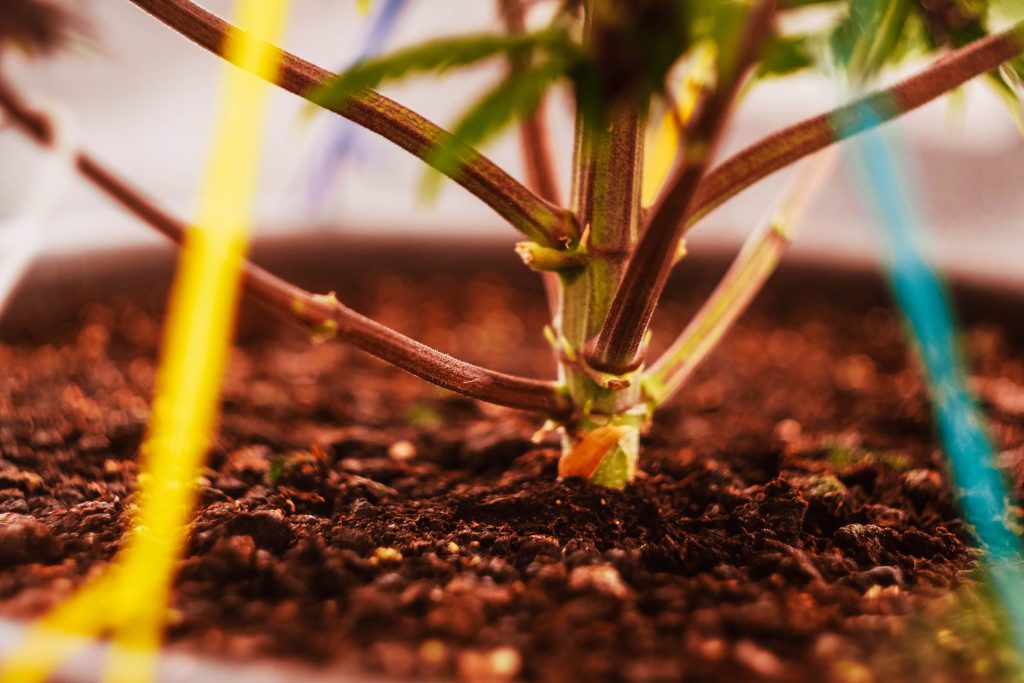
This low-risk, high-reward technique involves bending branches down to grow horizontally instead of vertically. New growth from the horizontal branches will grow vertically and fill the canopy area with numerous, equally tall branches. Low-stress training (LST) is an excellent tool to help control tall sativa cultivars in low-ceilinged grow spaces or tents.
LST is a common practice indoors. Increasing light exposure to lower branches is more critical than outdoors, where the sun hits the plant from every angle. Outdoor growers generally focus on supporting heavy limbs instead of sculpting the plant, but LST is an excellent tool for reducing height if an outdoor grow must remain incognito.
In both of these plant training methods, the cannabis plant will undergo some stress. LST (as the name explains) is low-stress and should not impede the plants’ growth rate. HST is high-stress, which involves cutting the plant and sometimes breaking cellular walls. HST can cause the growth to stall for a few days as the cannabis plant focuses on recovery and repair. Both styles suit regular and feminised seeds, but only LST should be used on automatic cannabis strains due to their short growth cycle and limited recovery time.
Why do we use LST
Cannabis needs intense light to grow to its fullest potential. Light follows the Inverse Square Low, which means that light gets significantly weaker the further the measurement (canopy) is from the source. By creating a level canopy, the majority of bud sites are on an equal plane, and the lighting fixture can be placed closer to them. This can increase the grower’s yields because the top of the cannabis plant receives higher light intensity, which promotes the growth of larger buds.
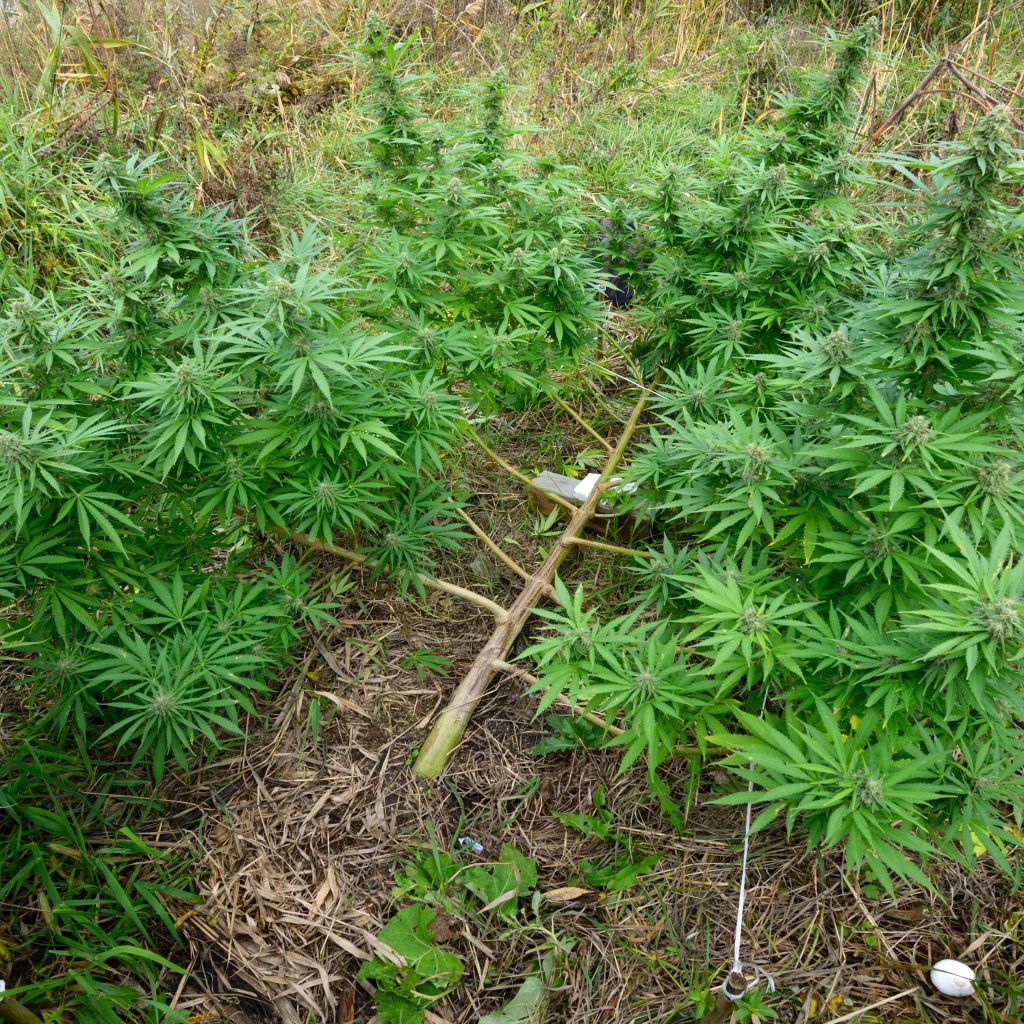
Creating a level canopy also breaks a phenomenon in the cannabis plant called apical dominance, where the central stem grows more than the lateral branches. Breaking apical dominance allows the lateral branches to receive more chemicals that stimulate plant growth. When LST is used to train the plant to grow an even canopy of lateral shoots, their size and yield are directly increased.
Other immediate benefits of using LST in the garden include increased airflow and maximising indoor garden space. Tightly packed branches with heavy foliage can lead to micro-climates within the canopy. Trapped, stale, warm, and moist air can lead to mould issues. Using LST to spread out the branches increases airflow and reduces the risk of mould.
Maximising the plants’ footprint by spreading it out is another benefit. This can be achieved by bending and tying down branches, but using a SCROG net is also highly effective. By guiding the vertical growing branches into different squares of a SCROG net, growers can make use of the full grow area. When low-stress training is done efficiently, a single cannabis plant canopy can fill an entire 122 cm x 122 cm grow tent.
Materials needed for low-stress training
To use LST, only a few materials are required. Growers need something to tie to the branch they want to manipulate and something to attach it to. In the case of a SCROG net, gardeners will need one that fits the garden’s dimensions or can be cut to fit any size.
To tie down branches, cannabis growers should look for rubber or protective-coated wire. If using thin metal wire with no coating, like a twist-tie, this metal can cut into the branch as it continues to gain girth. Quality plant ties will have a protective coating over the wire to avoid this, giving the piece strength.
Once the wire is attached, it still needs to be anchored somewhere. Most cannabis growers will use the sides of the pots as their anchor point. However, not all containers are equipped with holes to attach the wire, so growers have become creative. It is common to drill holes in the lip of plastic containers, but an insider tip is to use binder clips attached to the lip as the anchor point. These can easily be moved into the exact position needed.
In recent years, LST training clips have also come onto the market. These are plastic pieces with a bend in them. They attach to the branches by clipping them in place, redirecting growth. One drawback is that more will be needed as the plant grows outward and turns up to resume vertical growth.
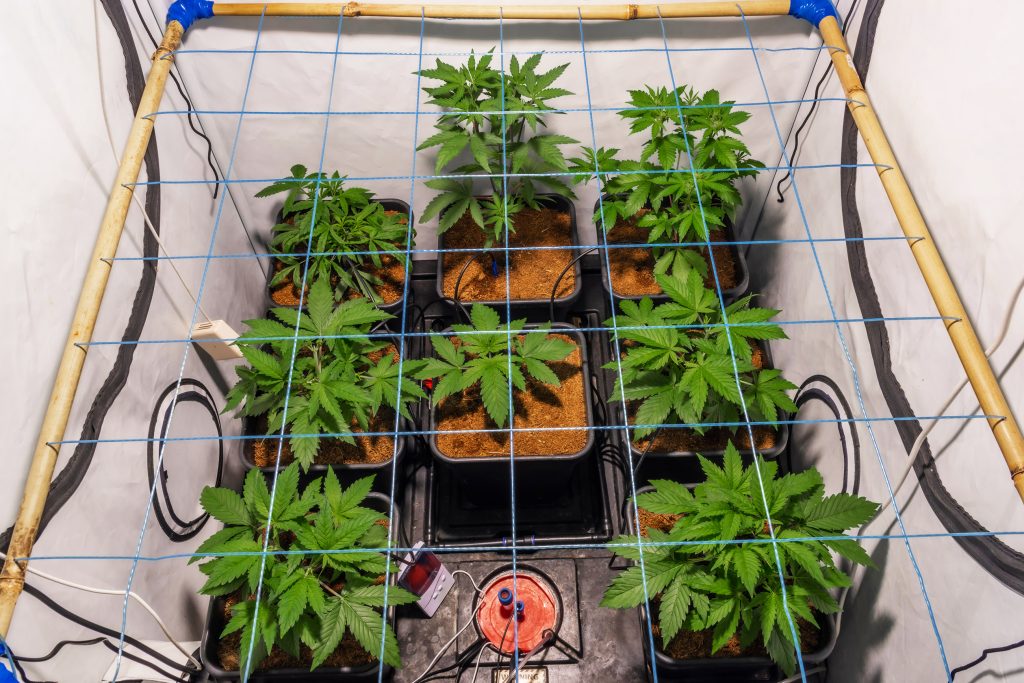
SCROG nets are usually a one-time-use item. The branches and buds grow through the net, and removing it in one piece at harvest can be a clumsy and plant-damaging effort. Cutting the SCROG net away is common as plants are removed and harvested. For that reason, polycarbonate/plastic netting is commonly used. Always dispose of any excess netting correctly, as it can pose a threat to wildlife.
Some growers use string or twine to secure branches or as a SCROG net. There are better materials to use that are widely available. String and twine have the ability to retain moisture. In humid environments (specifically close to the soil line when tying branches down), this residual moisture can harbour problematic mould spores that can then infect your cannabis plants.
In the case of using string or twine for a SCROG net, the little fibres can become trapped in the buds, which is less than desirable. Due to contaminants and the increased potential of mould, neither string nor twine is ideal for this purpose. Both of the above problems can be avoided by using the optimal materials.
When to apply low-stress training
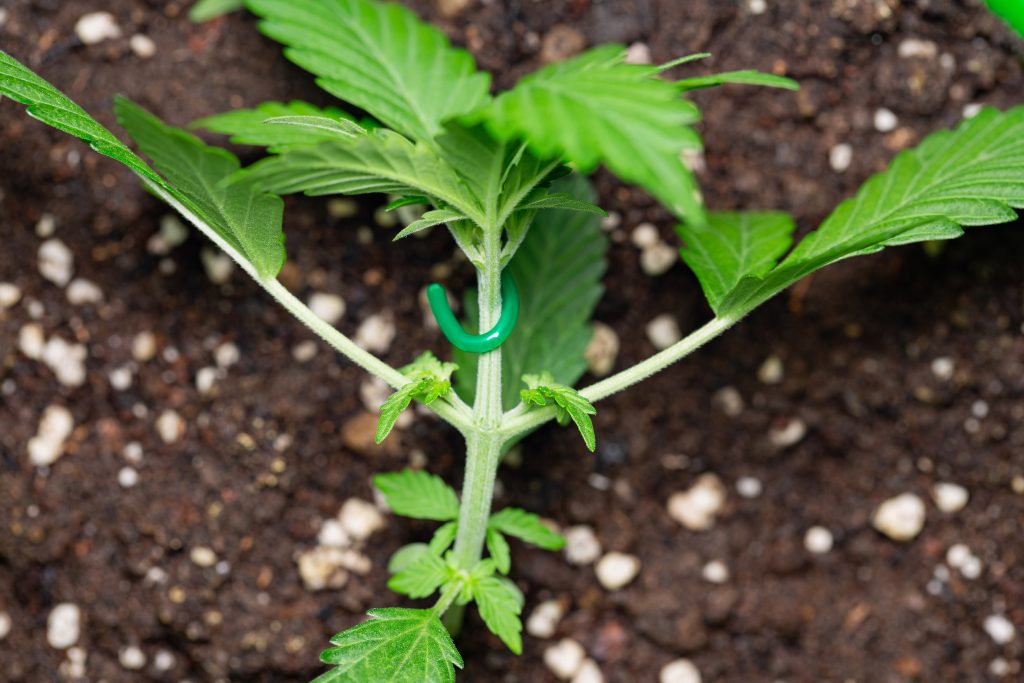
The majority of LST work will be performed in the early vegetation stage. The main stem and lateral branches will be at their softest and, therefore, easiest to bend. As branches get more extensive and have more weight to support, they become thick and woody, making them tougher to bend and more likely to break. Those branches can also be bent with practice, but it is better to begin LST early.
The focus of low-stress training is maintaining a level canopy. After the initial horizontal bends, the branches will resume growing upwards towards the light. Routine maintenance is needed to tie those vertical ends back down as they continue to grow. Gardeners will continue LST work, shaping the plant until the flowering stage begins.
As flowering commences, cannabis plants are usually put into a SCROG if the grower has not already installed their nets. Branches can be gently bent under the net to increase the horizontal footprint. This is generally the last time gardeners use LST or other plant training methods during the crop.
Before beginning low-stress training or other plant training techniques, the cannabis plant should have a developed root system. Experienced growers often wait to begin this work until the plant has at least five nodes. It is often best to start LST after transplanting the cannabis plant into its final destination, especially when anchoring the branches to the pot.
What is the best method for bending branches?
The tallest vertical tip will often be the most prominent bend since the purpose is to bring it level with the lowest branch tip. With new growth, it is easier to bend, but even with more mature branches, always hold the stem a few cm from where it connects to the main stem.
As the branch is slowly bent down, brace that area so that the joint where the branch meets the main stem is not absorbing the pressure, which risks the potential of snapping.
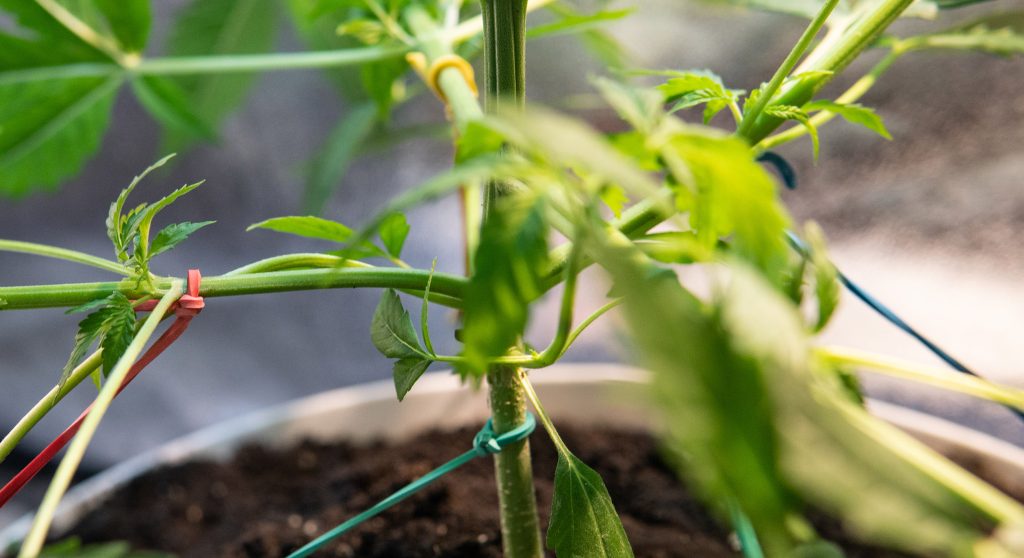
Bends can be made progressively; branches do not need to reach the final destination immediately. Stubborn branches can be bent lower and lower each day (or hour) until they reach the desired height. It is better to work slowly and gradually than risk a significant break.
For branches that are not easily pliable, gently pinch and rub the stem together. Softening the cell walls will make the branch easier to bend in that location. However, more than one bend point may be needed when using LST to achieve horizontal growth.
What to do if a branch breaks?
Do not worry, do not panic. If it is still attached slightly, there is a good chance to save it. The only materials needed are some tape and some time. Before using tape, adjust the branch back to its original position and minimise any exposed wound.

Use a tape that can stretch as that area grows; plant tape or even electrical tape are good choices. If the lateral branch has broken where it attaches to the main stem, wrap the tape under it, around the main stem, and back over the top of the broken branch. Do this pattern a few times to secure it.
If the branch needs extra support, a bendy wire can be used temporarily to brace it. A bamboo stake in the soil can also be used for support. Be gentle in the upcoming weeks as the wound heals. Generally, a snapped branch in mid-to-late flower is not worth saving because of the healing time involved.
Can growers use low-stress training on automatic strains?
Yes, LST can be used on automatic cannabis strains. The fear with training an automatic plant is that the recovery time will stunt the growth. LST is the gentlest form of plant training and can be done gradually. LST helps expand the footprint and increases the airflow within the average automatic strain. LST is also used to increase the yields of automatic varieties.
LST is a great way to increase cannabis yields, improve light efficiency, and maximise the space gardeners have to work with. It is a technique that can be applied to regular, feminised, and automatic seeds. It is the gentlest form of plant training, and new growers can successfully use LST techniques.
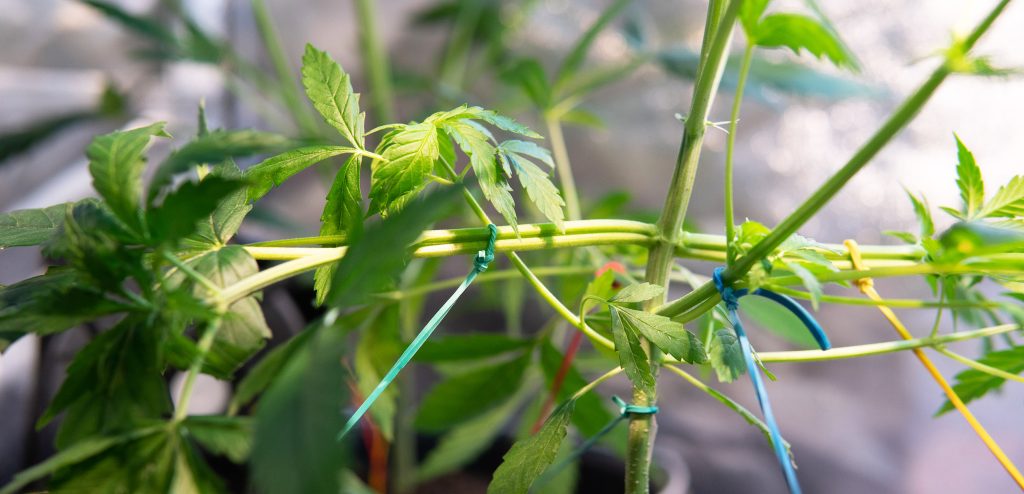
One part of the enjoyment of growing is working with the plants. LST gets the gardener into the grow space and regularly touching their plants. Progress can be checked daily, and the final shape is up to the gardeners’ imagination. There are incredible examples of shaped plants out there.
What has your experience been using LST in the garden? Is LST a common practice in the home garden, or is this a plant training technique you have been curious about? What shape of the plant do you aim for to increase yields? Please let us know your thoughts in the comments.
We hope you enjoyed this plant training article! Hungry for more cannabis cultivation information? Check out our other articles on the topic. Enjoy your time in the grow space, and happy gardening!
- Disclaimer:Laws and regulations regarding cannabis cultivation differ from country to country. Sensi Seeds therefore strongly advises you to check your local laws and regulations. Do not act in conflict with the law.






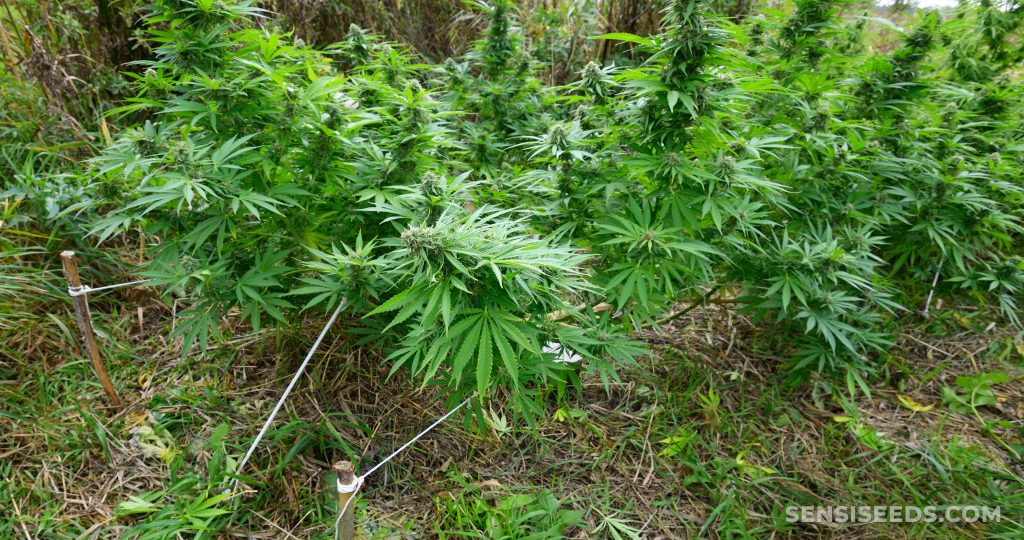

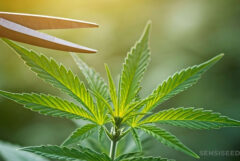
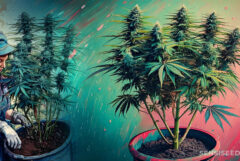

common sense good advice for starters. peace and love.